Learning Objectives
-
- Explain what is meant by intentional activities to support planning before, during and after the transition.
- Use a decision-making process to help a child and family be prepared for and adjust to a new environment.
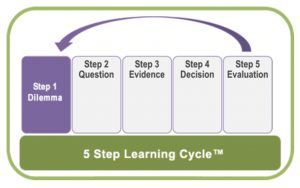 In Step 1, learners watch videos portraying the real world dilemma of childs transition to preschool viewed through the eyes of both the family and the receiving teacher. Learners are asked to describe the dilemma in an activity following the videos.
In Step 1, learners watch videos portraying the real world dilemma of childs transition to preschool viewed through the eyes of both the family and the receiving teacher. Learners are asked to describe the dilemma in an activity following the videos.
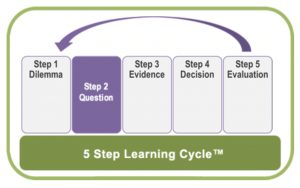 In Step 2, learners use a tool called PICO to turn the dilemma in Step 1 into an answerable question. The activity helps learners create a focused question that is answerable through research.
In Step 2, learners use a tool called PICO to turn the dilemma in Step 1 into an answerable question. The activity helps learners create a focused question that is answerable through research.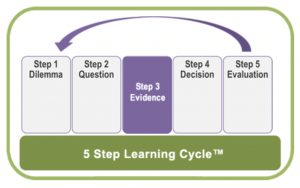 In Step 3, learners are presented with relevant sources of general evidence to consider in answering the question they posed in Step 2. Transition Practices are an intentional set of activities that promote communication between sending and receiving practitioners, engage families in collaborative planning, and support the preparation and adjustment of children and families to a change in settings or programs. Handouts of evidence are provided on research and policies related to transition. Learners listen to audio clips of practitioners and families sharing experience-based knowledge on transition. Activities for learners to check their knowledge are provided throughout this Step.
In Step 3, learners are presented with relevant sources of general evidence to consider in answering the question they posed in Step 2. Transition Practices are an intentional set of activities that promote communication between sending and receiving practitioners, engage families in collaborative planning, and support the preparation and adjustment of children and families to a change in settings or programs. Handouts of evidence are provided on research and policies related to transition. Learners listen to audio clips of practitioners and families sharing experience-based knowledge on transition. Activities for learners to check their knowledge are provided throughout this Step.
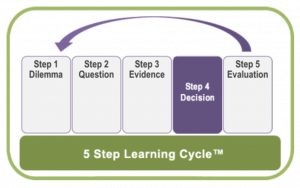 In Step 4, learners listen to audio perspectives of those involved in the dilemma to gain an understanding of their contexts. In an activity, they integrate the general evidence from Step 3 with perspectives and contexts unique to the dilemma in Step 1 to make an informed decision. Finally, learners are introduced to planning and implementation. Learners are asked to complete a Transition Plan in the culminating activity.
In Step 4, learners listen to audio perspectives of those involved in the dilemma to gain an understanding of their contexts. In an activity, they integrate the general evidence from Step 3 with perspectives and contexts unique to the dilemma in Step 1 to make an informed decision. Finally, learners are introduced to planning and implementation. Learners are asked to complete a Transition Plan in the culminating activity.
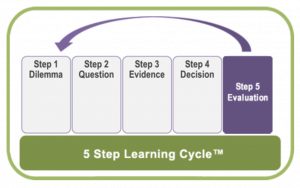
In Step 5, learners consider ways to evaluate the decision to use the practice. Learners determine:
- if the intervention was implemented, and
- if the intervention was effective.
Handouts are provided showing sample assessment methods.
- Dilemma
-
 In Step 1, learners watch videos portraying the real world dilemma of childs transition to preschool viewed through the eyes of both the family and the receiving teacher. Learners are asked to describe the dilemma in an activity following the videos.
In Step 1, learners watch videos portraying the real world dilemma of childs transition to preschool viewed through the eyes of both the family and the receiving teacher. Learners are asked to describe the dilemma in an activity following the videos. - Question
-
 In Step 2, learners use a tool called PICO to turn the dilemma in Step 1 into an answerable question. The activity helps learners create a focused question that is answerable through research.
In Step 2, learners use a tool called PICO to turn the dilemma in Step 1 into an answerable question. The activity helps learners create a focused question that is answerable through research. - Evidence
-
 In Step 3, learners are presented with relevant sources of general evidence to consider in answering the question they posed in Step 2. Transition Practices are an intentional set of activities that promote communication between sending and receiving practitioners, engage families in collaborative planning, and support the preparation and adjustment of children and families to a change in settings or programs. Handouts of evidence are provided on research and policies related to transition. Learners listen to audio clips of practitioners and families sharing experience-based knowledge on transition. Activities for learners to check their knowledge are provided throughout this Step.
In Step 3, learners are presented with relevant sources of general evidence to consider in answering the question they posed in Step 2. Transition Practices are an intentional set of activities that promote communication between sending and receiving practitioners, engage families in collaborative planning, and support the preparation and adjustment of children and families to a change in settings or programs. Handouts of evidence are provided on research and policies related to transition. Learners listen to audio clips of practitioners and families sharing experience-based knowledge on transition. Activities for learners to check their knowledge are provided throughout this Step. - Decision
-
 In Step 4, learners listen to audio perspectives of those involved in the dilemma to gain an understanding of their contexts. In an activity, they integrate the general evidence from Step 3 with perspectives and contexts unique to the dilemma in Step 1 to make an informed decision. Finally, learners are introduced to planning and implementation. Learners are asked to complete a Transition Plan in the culminating activity.
In Step 4, learners listen to audio perspectives of those involved in the dilemma to gain an understanding of their contexts. In an activity, they integrate the general evidence from Step 3 with perspectives and contexts unique to the dilemma in Step 1 to make an informed decision. Finally, learners are introduced to planning and implementation. Learners are asked to complete a Transition Plan in the culminating activity. - Evaluation
-

In Step 5, learners consider ways to evaluate the decision to use the practice. Learners determine:
- if the intervention was implemented, and
- if the intervention was effective.
Handouts are provided showing sample assessment methods.
Step 1: Dilemma
Step 3: Evidence
Step 3: Evidence
Handout 2.1: Child Transition Profile
Handout 2.2: Child Transition Profile – Sample
Handout 2.3: Home Visit Planning Form
Handout 2.4: Home Visit Planning Form – Sample
Handout 2.5: Follow-up Home Visit Sheet
Handout 2.6: Observation Guide for Initial Class Visit
Handout 2.7: Phase-In Transition Days Plan
Handout 2.8: Research Summary on Transition Practices in Early Childhood
Handout 2.9: Policy Advisory: The Law Governing Transition of Young Children
Step 4: Decision
Step 3: Evidence
Step 4: Decision
Audio 2.5: Rosemary’s Perspective (Tamiya’s mother)
Audio 2.6: Melanie A.’s Perspective (receiving teacher)
Audio 2.7: Randah’s Perspective (physical therapist)
Audio 2.8: Melanie B.’s Perspective (Tamiya’s early intervention service coordinator)
Audio 2.9: Judy’s perspective (program administrator in Tamiya’s new program)

